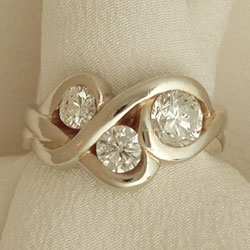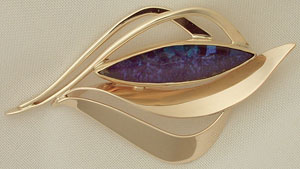  |
||||||||||||||||||||||||||||||||
| Education
Click on any of the links below to take you to additional information about the subject listed. Please don't hesitate to call or drop us a note if you have any more questions.
Gold is the most malleable precious metal. One ounce of pure gold can be rolled into a 100 square foot sheet just five millionths of an inch thick! That same ounce can be drawn into a wire thread over 50 miles long. Aside from pure gold (24 karat), all gold jewelry is an alloy (pure gold mixed with other metals). If itÕs 75% pure gold and 25% other metals, itÕs 18K (marked 750 in Europe). Something stamped 14K has to be exactly 58.5% pure gold (585 in Europe), and 10K is 41.6% pure gold (the lowest legal karatage in the US). As you know, gold comes in different colors, which is where those Òother metalsÓ come in. To create gold for jewelry where you donÕt want 24K (which is usually too soft), copper and silver are used. When the percentage of copper relative to silver is increased, it becomes pink (or rose) gold. But the more copper, the more brittle it will be. Using more silver and less copper results in green gold (which looks more like a greenish tinted yellow than a true green). When white gold is desired, the normal combination is nickel and copper added to the pure yellow gold. Nickel causes allergic reactions in some people and is banned in Europe as an alloy. There, silver and palladium (an expensive member of the platinum family) are used. Some newer colors are peach gold, brown, blue, and even purple gold (which is made with aluminum!).
WHAT TO LOOK FOR
Look at the craftsmanship. Is it well made? Do chain and pin catches work properly; are earring posts and nuts strong; is the soldering invisibleÉ? In addition to craftsmanship, design is a very important consideration. The karat stamp and the weight will tell you only how much gold is in the piece. It doesnÕt reflect the uniqueness or beauty of the design (or how well it was made). For fine jewelry that you want to last and enjoy wearing, these last two factors are the most important. |
||||||||||||||||||||||||||||||||
© 2008 - Refined Designs Original Fine Jewelry | All rights reserved | 518-765-3750 |
||||||||||||||||||||||||||||||||
 Even
though we see gold every day, itÕs actually a relatively rare mineral.
Pure gold is present in the earthÕs crust in the amount of only about
4 parts per billion. Surprisingly, itÕs rarer than platinum at 45 parts
per billion (but platinum is much more expensive to mine). A substantial
amount of earth has to be mined and processed, so much that a yield
of one ounce from five tons of ore is considered a rich find. Some
mines run over 7000 feet deep, and the recovery cost can be very high.
Even
though we see gold every day, itÕs actually a relatively rare mineral.
Pure gold is present in the earthÕs crust in the amount of only about
4 parts per billion. Surprisingly, itÕs rarer than platinum at 45 parts
per billion (but platinum is much more expensive to mine). A substantial
amount of earth has to be mined and processed, so much that a yield
of one ounce from five tons of ore is considered a rich find. Some
mines run over 7000 feet deep, and the recovery cost can be very high. White
gold is a relatively new precious metal. By 1900, platinumÕs popularity
increased enough to make it more expensive than gold for the first
time, so the search was on for an alloy of gold that would give it
a white color. The search was heightened during WWI when restrictions
were placed on the use of platinum where it was used for explosives.
In 1915 a US patent was granted for a formula for white gold. None
too soon: WWII brought about a complete restriction on platinum for
jewelry, and by the warÕs end, white gold had taken over platinumÕs
role for some time to come. It would take over 30 years before platinum
would make a comeback. (See the platinum section for more on this.)
White
gold is a relatively new precious metal. By 1900, platinumÕs popularity
increased enough to make it more expensive than gold for the first
time, so the search was on for an alloy of gold that would give it
a white color. The search was heightened during WWI when restrictions
were placed on the use of platinum where it was used for explosives.
In 1915 a US patent was granted for a formula for white gold. None
too soon: WWII brought about a complete restriction on platinum for
jewelry, and by the warÕs end, white gold had taken over platinumÕs
role for some time to come. It would take over 30 years before platinum
would make a comeback. (See the platinum section for more on this.)  Does
it have some heft, or does it feel lightweight due to hollow areas
or places that are very thin?
Does
it have some heft, or does it feel lightweight due to hollow areas
or places that are very thin?